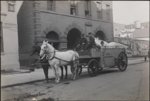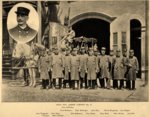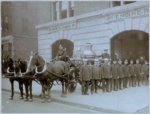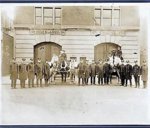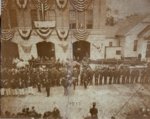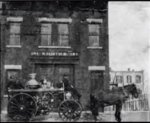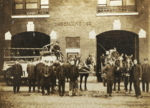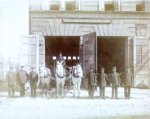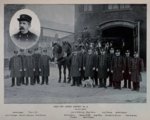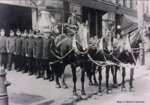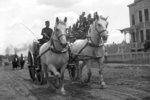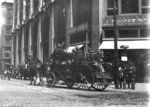You are using an out of date browser. It may not display this or other websites correctly.
You should upgrade or use an alternative browser.
You should upgrade or use an alternative browser.
FDNY and NYC Firehouses and Fire Companies - 2nd Section
- Thread starter mack
- Start date
New York's Fire Horses
Horses pulled the fire wagons in New York from 1832 till 1917, and were a source of great pride for firemen, who showed them at the National Horse Show in Madison Square Garden. By Fran Jurga for EquiSearch.
At first, horses were not popular with the New York Fire Department. In the 1800s, firemen resisted getting horses to pull the fire wagons because they thought it would put men out of work, since the fire wagons were pulled by humans, not horses.
In 1832, a cholera epidemic in New York limited the availability of firemen to pull the trucks, so they brought in the first fire horse. A rival neighborhood's fire crew broke into the stable, shaved the horse's mane and tail, and painted a skunk-like stripe down the horse's back. It took more than 20 years before another NY fire station dared use a horse.
Once the fire department adopted the horse idea, the New York fire horses were among the finest in America; they were even shown in the National Horse Show in Madison Square Garden. They also had farrier wagons that raced to the scene of a fire in the event that the fire horses threw shoes in their haste to get to the fire. And that did happen. A thrown shoe from a fast-galloping fire horse once broke a third-story window.
The well-kept fire horses of New York probably never knew the irony of their frequent calls to stable fires throughout the city, especially lower Manhattan. The area around the site of the World Trade Center was dense with horse barns. Horses were kept at night on the upper floors of barns, with carriages and harness on the ground floor.
When the stables of a lower Manhattan ferry company burned, 1,200 horses were trapped inside. The New York Fire Department was prompted to write a report expressing its frustration at not being able to save helpless horses during the frequent stable fires.
An epidemic of distemper (called simply "the epizootic", or epidemic) hit the United States in 1872, bringing the nation's transport to a halt. In Boston, four fire horses died and virtually all the city's fire horses were declared unfit for service. It was not safe to bring fresh horses into the city until the disease died down, so firefighters were pressed to pull their own fire wagons; only one fire station had a team of horses healthy enough to answer the call.
The timing was bad; on November 9, what would come to be known as the Great Boston Fire broke out, destroying 776 buildings and killing 14 people, including 11 firefighters. Historically, the lack of horses is blamed for the city's inability to contain the fire.
The three-abreast hitch was popular with fire departments. Interestingly, the middle horse was recorded as the one first to break down and have lameness problems. Once this happened, the entire team was retired, since firemen believed that a replacement in the hitch would be a bad omen.
A startling feature of looking at archives of fire horse photos is that they usually did not wear blinkers, as most driving horses do.
Firemen were known to be very attached to their horses and maintained accounts to pay the retirement expenses of their horses. They were even

Horses pulled the fire wagons in New York from 1832 till 1917, and were a source of great pride for firemen, who showed them at the National Horse Show in Madison Square Garden. By Fran Jurga for EquiSearch.
At first, horses were not popular with the New York Fire Department. In the 1800s, firemen resisted getting horses to pull the fire wagons because they thought it would put men out of work, since the fire wagons were pulled by humans, not horses.
In 1832, a cholera epidemic in New York limited the availability of firemen to pull the trucks, so they brought in the first fire horse. A rival neighborhood's fire crew broke into the stable, shaved the horse's mane and tail, and painted a skunk-like stripe down the horse's back. It took more than 20 years before another NY fire station dared use a horse.
Once the fire department adopted the horse idea, the New York fire horses were among the finest in America; they were even shown in the National Horse Show in Madison Square Garden. They also had farrier wagons that raced to the scene of a fire in the event that the fire horses threw shoes in their haste to get to the fire. And that did happen. A thrown shoe from a fast-galloping fire horse once broke a third-story window.
The well-kept fire horses of New York probably never knew the irony of their frequent calls to stable fires throughout the city, especially lower Manhattan. The area around the site of the World Trade Center was dense with horse barns. Horses were kept at night on the upper floors of barns, with carriages and harness on the ground floor.
When the stables of a lower Manhattan ferry company burned, 1,200 horses were trapped inside. The New York Fire Department was prompted to write a report expressing its frustration at not being able to save helpless horses during the frequent stable fires.
An epidemic of distemper (called simply "the epizootic", or epidemic) hit the United States in 1872, bringing the nation's transport to a halt. In Boston, four fire horses died and virtually all the city's fire horses were declared unfit for service. It was not safe to bring fresh horses into the city until the disease died down, so firefighters were pressed to pull their own fire wagons; only one fire station had a team of horses healthy enough to answer the call.
The timing was bad; on November 9, what would come to be known as the Great Boston Fire broke out, destroying 776 buildings and killing 14 people, including 11 firefighters. Historically, the lack of horses is blamed for the city's inability to contain the fire.
The three-abreast hitch was popular with fire departments. Interestingly, the middle horse was recorded as the one first to break down and have lameness problems. Once this happened, the entire team was retired, since firemen believed that a replacement in the hitch would be a bad omen.
A startling feature of looking at archives of fire horse photos is that they usually did not wear blinkers, as most driving horses do.
Firemen were known to be very attached to their horses and maintained accounts to pay the retirement expenses of their horses. They were even

New York's Fire Horses
Horses pulled the fire wagons in New York from 1832 till 1917, and were a source of great pride for firemen, who showed them at the National Horse Show in Madison Square Garden. By Fran Jurga for EquiSearch.
equusmagazine.com

